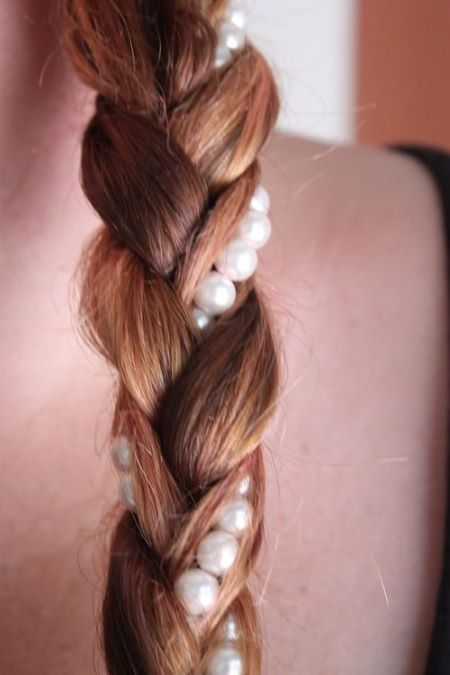What is an Add-A-Pearl Necklace?
- By Patti Dechter
- May 21, 2019

Add-A-Pearl is a way to create a complete strand of pearls over a period of time. The original gift is usually a single pearl necklace presented to a baby or young girl with one or more pearls on a 14-kt gold chain. Through the years, pearls can be added whenever friends and family wish to make an addition until the necklace becomes either a full strand of pearls or until the preferred number of pearls or look is achieved, perhaps at 16 or 22 pearls symbolizing a sweet 16 or college graduation. Most often, pearls are given for birthdays and at holiday time. Valentine’s Day, Easter, confirmation, graduation and other special milestones offer ideal opportunities to add pearls.
Add-A-Pearl is a brand name owned and operated by The Juergens & Andersen Company. Juergens and Andersen Company has been in business since 1854. The Add-A-Pearl necklace began in 1915 as a way for parents and grandparents to create a natural pearl necklace for their little girls. Natural pearls, otherwise known as genuine, real or oriental pearls are 100% formed in nature. Usually a small particle becomes embedded in the soft fleshy part of an oyster. To relieve the irritation, the oyster secretes layers of nacre which forms around the irritant thereby producing the natural pearl’s unmistakable iridescence. Effectively, natural pearls are pure pearl all the way from the core to surface. Natural pearls were once the most highly coveted of all gems due to their rarity and exclusivity and Add-A-Pearl offered an economical way to create a full strand of natural pearls over time. Natural pearls were the most highly sought gems of the early 1900s until cultured pearls were later introduced and grew in popularity. Cultured pearls, on the other hand, are nucleated to stimulate the oyster into secreting nacre. Cultured pearls are composed of the same material (nacre) as natural pearls, but with a little help starting the process. Once Kokichi Mikimoto perfected his technique for culturing pearls by nucleating oysters with mantle tissue, cultured pearls became the pearls of choice due to their increased availability and affordability.
Cultured pearls is a category of pearls which can be further broken down into types of pearls including South Sea, Tahitian, Freshwater and Akoya. The most popular type of cultured pearls used for necklaces are Freshwater and Saltwater (Akoya). There are definite differences between Freshwater and Saltwater pearls. Saltwater pearls are nucleated with a rounded piece of mother-of-pearl shell that has been wrapped with mantle tissue and embedded into the oyster. Freshwater pearls are nucleated with mantle tissue only. This is important to note is because the internet is rife with misinformation about pearls and disparate price differences. Many websites started claiming Freshwater pearls as Natural pearls because Freshwater pearls are nucleated with mantle tissue which is an organic material. In many cases, the nature of the nucleus denotion is intended to obfuscate the distinction between natural and cultured. The fact remains that Freshwater pearls and saltwater pearls are both cultured pearls. Only pearls that have not been cultured should be recognized as natural pearls. Furthermore, freshwater pearls are most commonly produced in abundance in China. They are cheaper and less lustrous than the beautiful Japanese Akoya Cultured pearls. Akoya pearls have long been known for their near-perfect roundness and deep beautiful luster, an important distinction compared to their Freshwater, less lustrous counterparts.
According to the FTC Buyers Guidelines, only pearls that have not been cultivated should be referred to as natural pearls. All other pearls require a specific designation to protect consumers and help buyers obtain accurate information when they are shopping for jewelry.
Although there are other types of add-on pearl products available from other companies, Add-A-Pearl is a trademarked name registered with the US patent office to signify necklaces that originated from the Add-A-Pearl Company consisting of necklaces using Akoya cultured pearls or genuine natural pearls. The Add-A-Pearl name is stamped near the clasp on every necklace indicating the pearls have been evaluated and approved for Add-A-Pearl necklaces. When adding pearls to your necklace, be sure the pearls are on one of the Add-A-Pearl cards to ensure the authenticity of your pearls. Add-A-Pearl guarantees the type, quality and beauty of pearls on an Add-A-Pearl card.
Long ago, the tradition of Add-A-Pearl began as a way to assemble a necklace of great value by collecting pearls over time. Add-A-Pearl has been going strong since 1915 through the years, its unique legacy continues to grow, just like the beauty of each Add-A-Pearl necklace continues to grow.













